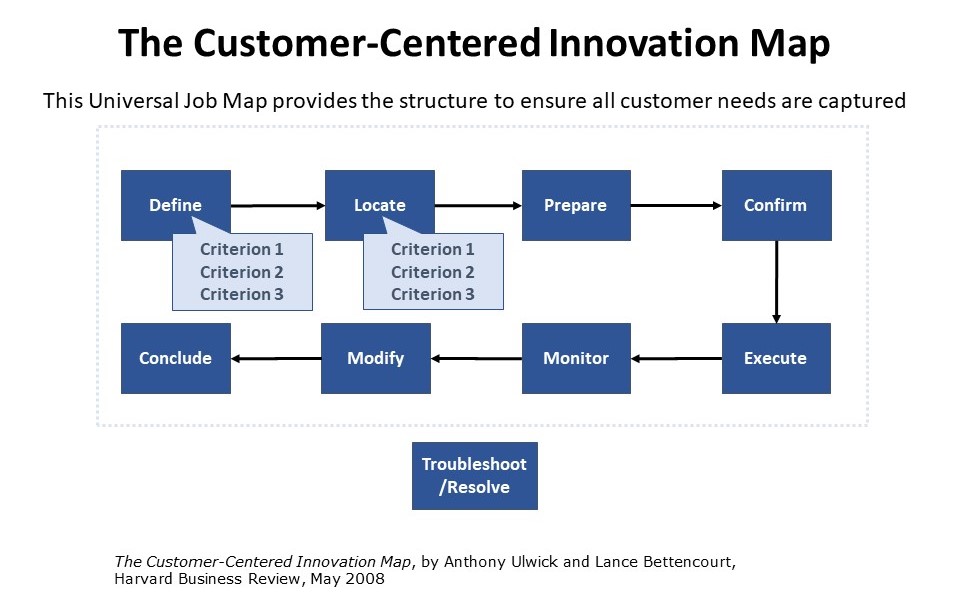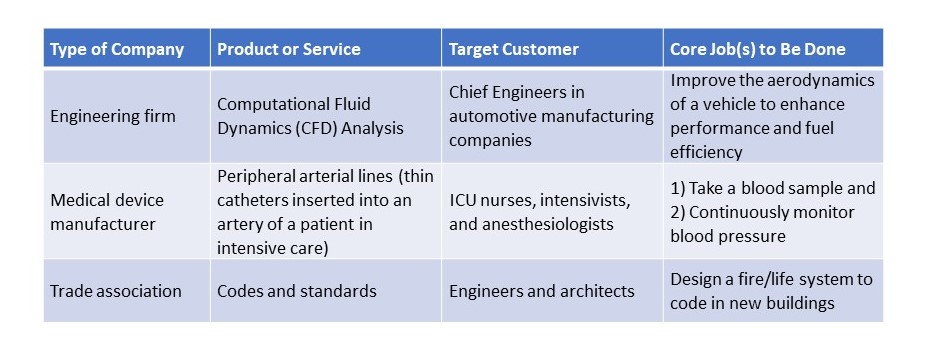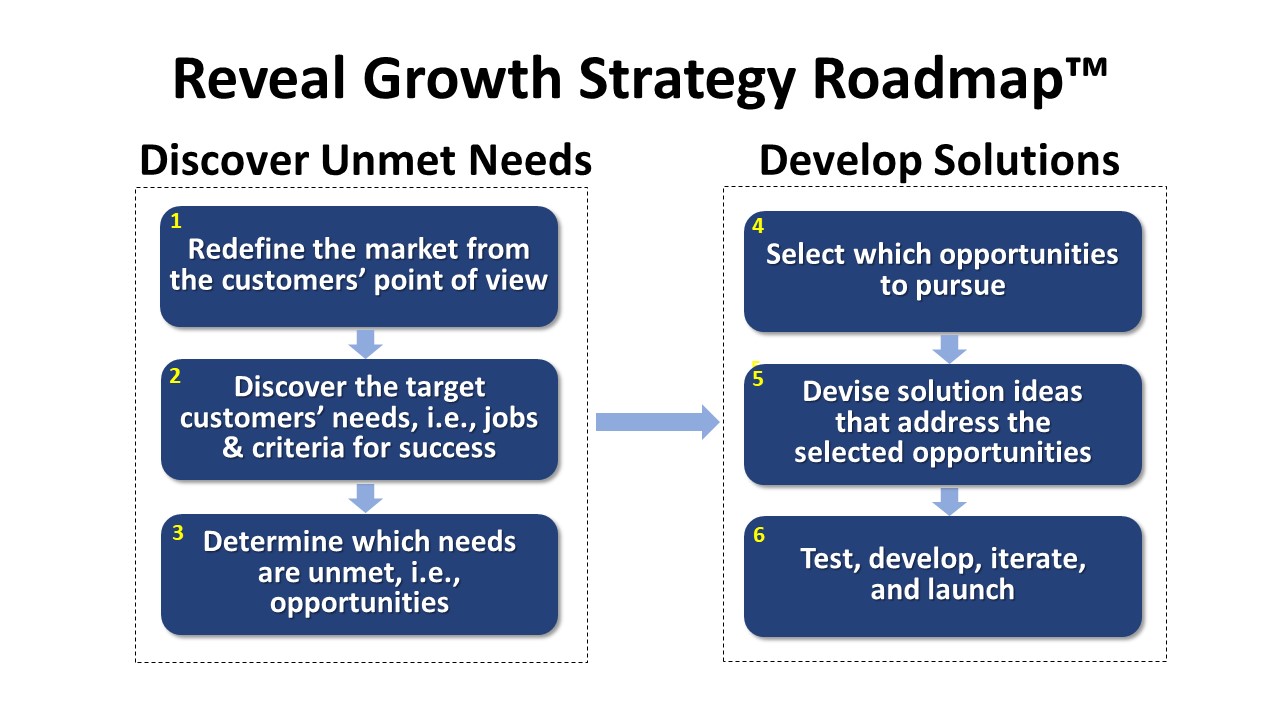To Drive Growth in a Core Market, Forget About Your Offer!
Establishing a competitive advantage is hard for most companies. That’s often because they don’t know which of their target customers’ needs are going unmet by their own offerings and their competitors’ offerings. This leads to a guessing game, high failure rates, wasted time and resources, opportunity costs, and a lot of frustration. All of this is largely unnecessary but quite common for many companies today. Let’s look at how Jobs-to-Be-Done (JTBD) resolves this problem and enables companies to drive growth in a core market in a repeatable manner.
Driving growth in a core market is a great place to start an innovation initiative because it’s low risk and almost always reveals significant opportunities for new value creation. It’s low risk because it builds on your current products and services and an established customer base. While “disruptive innovation” gets a lot of headlines, the vast majority of successful innovation initiatives are sustaining and incremental building on current products and services. But that doesn’t mean they can’t deliver a big impact. When you use a JTBD approach to grow a core market, it’s common to find 10-20 opportunities for improvement. A simple 2% improvement in customer satisfaction on 10 of those opportunities delivers a 20% improvement overall. That’s a game-changer.
Even in mature markets where it appears all the customers’ needs are well satisfied, there are virtually always jobs-based market segments with significant opportunities that your competitors don’t know about. That’s because most companies are still segmenting their markets according to demographics or psychographics which often have no correlation with customer purchasing behavior. JTBD segmentation, on the other hand, finds segments of opportunity based on what customers are trying to accomplish and thereby reveals causality – i.e., why customers buy a product or service.
We start a core market study the same way we start every JTBD study by asking, “Who are your target customers?” and “What job(s) are they trying to get done with your offering?” Your answer to these two questions defines your market. JTBD changes the game of innovation by decoupling customer needs from products and services. That makes it possible to obtain a comprehensive set of customer needs in virtually any market and then identify and rank the biggest opportunities with statistical validity. This is how JTBD delivers pre-qualified opportunities with precision. And it all starts with redefining the market as a “group of people” and “the core job they want to get done.” The table below illustrates how this looks.
The answers to “Who is your target customer” and “what are they trying to get done with your product or service” might seem obvious, but appearances can be deceiving. There are a few common hazards you’ll want to avoid.
The first hazard is defining the core job based on the product or service the company sells rather than on what customers are trying to get done. For example, a firm may offer electrical engineering services to the construction industry, but customers want to design fire/life systems to code in new buildings. A firm may offer training, but customers want to learn a subject. Engineering services may not be the best way to design a fire/life system to code, and teaching may not be the best way for students to learn a subject. (It’s been shown that the best way to learn something is to teach it. Therefore, students should be teaching.)
A second hazard is not targeting the most important customer. That’s usually the end-user because the market exists to create value for the end-user. Nonetheless, sometimes it’s helpful to ask:
- Who has the most authority to evaluate the quality of your offering?
- Who stands to lose the most if something goes wrong?
- If there’s a problem, who has to fix it?
A third hazard is not interviewing all the people involved in getting a job done. For example, it usually takes a few different professionals to execute a surgical procedure. To help a medical device manufacturer upgrade their “peripheral arterial lines” (thin catheters inserted into an artery of a patient in intensive care), we interviewed ICU nurses, intensivists, and anesthesiologists. That’s because any new or improved arterial line would have to meet the approval of all three professionals responsible of “taking a blood sample” and “continuously monitoring blood pressure,” the two jobs they all “hired” arterial lines to get done but with different success metrics.
Once the target customer and core job have been validated with customers, you can build a job map. Job maps are a visual depiction of the process steps customers must go through to execute a functional job. Job maps are different from customer journey maps in that job maps do not document how customers interact with the company and its product/service; it documents the steps customers must execute to get the job done regardless of what product or service they use. Hence, JTBD gives us a lens to see the world as customers see it, not as we see it.
Tony Ulwick, CEO and Founder of Strategyn and the chief pioneer of the JTBD approach, and former Strategyn Senior Consultant, Lance Bettencourt, authored a popular article in the Harvard Business Review article entitled “The Customer-Centered Innovation Map.” This job map gives practitioners a framework to consistently uncover the steps customers are trying to execute as well as the criteria they use to measure success when navigating through each step. Customers have to go through these steps (see below) to execute a functional job regardless of whether you provide a product or service solution. Some jobs may have multiple sub-steps within a step and some steps may be unnecessary but, regardless, this universal job map gives us a roadmap for developing any target customer’s job to be done.

Caution: it may be that the job customers are trying to get done with your offering is only one step in a larger job. In such cases, you’ll want to make sure that you, first, nail the step that your offering addresses and then consider how you can help customers get more steps done, preferably all their steps done. A product or service that helps customers get all their steps done is a lot more attractive – and valuable – than pulling together a hodgepodge of different solutions.
In addition to capturing the customers’ job steps and criteria for success, it’s also important to capture the customers’ emotional and social jobs as well – i.e., how they want to feel (avoid feeling) and be perceived (avoid being perceived) – and other related functional jobs that they’re trying to get done before, during, or after executing the core job. Other related jobs that are important and unsatisfied are potential blue ocean new market opportunities. (See A Better Way to Formulate Blue Ocean Strategy). This is another effective way to drive growth.
The Customer-Centered Innovation Map was the inspiration for the Reveal Growth Strategy Roadmap™ that we use with clients. You could say it’s a “Supplier-Centered Innovation Map.” These are the six steps we believe every supplier should execute to turn innovation into a repeatable business process. Of course, it takes some expertise and experience to do it. We can help you with that.
Was this helpful? Did it raise some questions for you? I always enjoy hearing from readers. Contact me at uw@revealgrowth.com.






